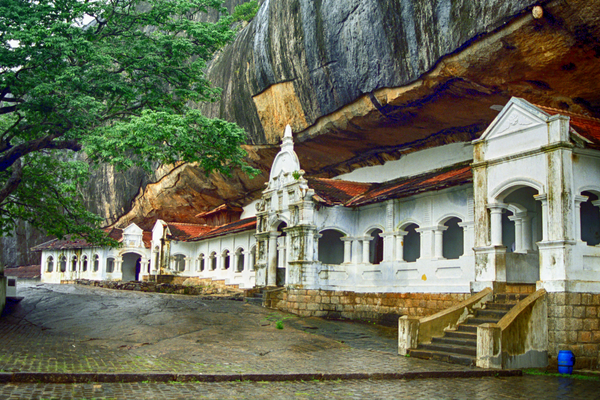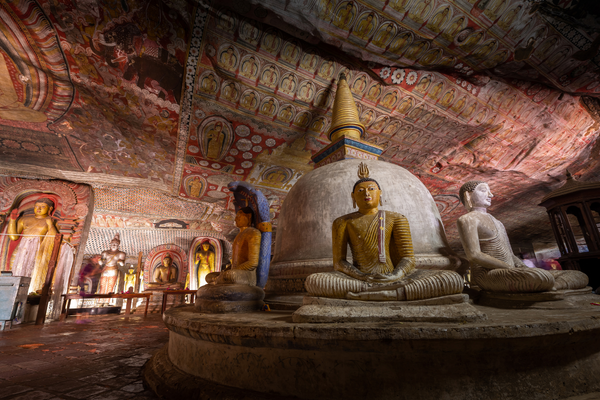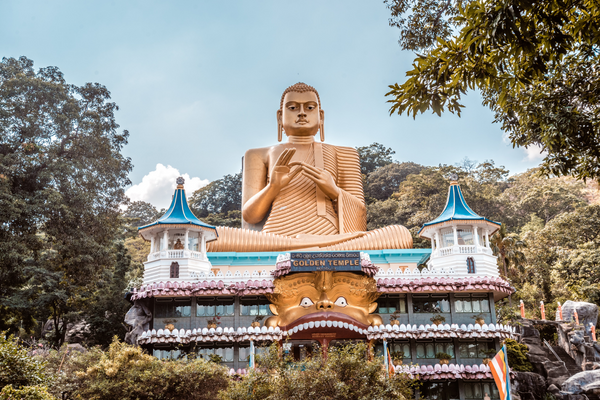cave temple dambulla sri lanka – By Malsha – eLanka

The Dambulla Cave Temple, also known as the Golden Temple of Dambulla, is a UNESCO World Heritage Site located in Dambulla, Sri Lanka. The temple is a complex of five caves that contain a total of 153 Buddha statues, as well as paintings and intricate carvings covering the walls and ceilings. The caves are believed to have been used as a place of worship for more than 2,000 years and are considered some of the best-preserved examples of ancient Buddhist rock art in Sri Lanka. The temple is considered one of the most important Buddhist pilgrimage sites in the country and is visited by thousands of tourists each year.
The Dambulla Cave Temple is located in the central part of Sri Lanka, approximately 142 km east of Colombo. It is situated in the Matale District of the Central Province and is part of the cultural triangle of Sri Lanka, which also includes the ancient city of Anuradhapura and the rock fortress of Sigiriya. The temple is set in a steep hillside and is surrounded by lush green forests and fertile agricultural lands. The area is known for its rich cultural and natural heritage, and is a popular tourist destination for those interested in the history and culture of Sri Lanka. The nearby town of Dambulla is a bustling market town and serves as a convenient base for exploring the surrounding region.
The Dambulla Cave Temple is considered a special and unique site for several reasons:
- Age: The temple is believed to be over 2,000 years old and is one of the oldest continuously inhabited temple complexes in Sri Lanka.
- Art and Architecture: The temple is renowned for its well-preserved murals and sculptures, which cover the walls and ceilings of the caves. The intricate and detailed artwork is a testament to the artistic skills of ancient Sri Lankan artists.
- Religious Significance: The temple is considered one of the most important Buddhist pilgrimage sites in Sri Lanka and is revered by Buddhists throughout the country and beyond.
- Natural Setting: The temple is situated in a picturesque location on a hillside surrounded by lush forests and rolling hills, making it a peaceful and serene place to visit.
- Cultural Heritage: The Dambulla Cave Temple is a part of the cultural triangle of Sri Lanka, which also includes the ancient city of Anuradhapura and the rock fortress of Sigiriya. It is a significant part of Sri Lanka’s cultural heritage and has been designated a UNESCO World Heritage Site.
These factors make the Dambulla Cave Temple a truly special and unique site, and a must-visit for anyone interested in the history, culture, and religion of Sri Lanka.
The history of the Dambulla Cave Temple dates back over 2,000 years and is closely tied to the history of Buddhism in Sri Lanka. According to tradition, the caves were used as a place of refuge by King Valagamba (also known as Vattagamini Abhaya) during one of his periods of exile from Anuradhapura, the ancient capital of Sri Lanka. After regaining the throne, he is said to have converted the caves into a Buddhist temple.

Over the centuries, the temple was expanded and embellished by successive kings and patrons, and became an important center of Buddhism in Sri Lanka. The temple was also an important stop for travelers on the ancient Silk Road, which connected China and other parts of Asia with the West. During this time, the temple was a major center of trade and commerce, as well as a place of worship and pilgrimage.
In the late 19th and early 20th centuries, the temple fell into disrepair and was largely abandoned. However, it was later restored and renovated by the Sri Lankan government, and in 1991, the temple was designated a UNESCO World Heritage Site in recognition of its cultural and historical significance. Today, the temple is one of the most important Buddhist pilgrimage sites in Sri Lanka, and is visited by thousands of tourists and pilgrims each year.
The Dambulla Cave Temple is famous for its rich and well-preserved art, which covers the walls and ceilings of the five caves that make up the temple complex. The art includes sculptures, murals, and intricate carvings, and is considered some of the finest examples of ancient Buddhist rock art in Sri Lanka.
The sculptures at the temple include 153 statues of the Buddha, as well as other Buddhist deities and figures. The statues range in size from small, hand-held figures to larger-than-life depictions of the Buddha, and are made of various materials including stone, bronze, and stucco.
The murals and paintings at the temple depict scenes from Buddhist mythology and history, as well as scenes from the life of the Buddha. The paintings are richly colored and intricately detailed, and are considered some of the finest examples of ancient Sri Lankan art.
The carvings at the temple include intricate floral and geometric designs, as well as scenes from Buddhist mythology. The carvings are set against a background of natural rock formations, and are an integral part of the temple’s architectural and artistic design.
Together, the sculptures, murals, and carvings at the Dambulla Cave Temple represent a unique and powerful expression of ancient Sri Lankan Buddhist art and culture, and are a must-see for anyone interested in the history and culture of Sri Lanka.
The present situation of the Dambulla Cave Temple is that it is a well-preserved and thriving site of religious, cultural, and historical significance. The temple is considered one of the most important Buddhist pilgrimage sites in Sri Lanka and is visited by thousands of tourists and pilgrims each year.
The temple complex has been well-maintained and preserved by the Sri Lankan government, and much effort has been made to protect and restore its historical and cultural heritage. In 1991, the temple was designated a UNESCO World Heritage Site, and has since become a major tourist destination in Sri Lanka.

In recent years, the temple has also become an important center for Buddhist studies and research, and is regularly visited by scholars, students, and researchers from around the world. The temple is also an important cultural and educational resource for the local community, and is seen as a symbol of Sri Lanka’s rich cultural and religious heritage.
Despite the challenges posed by the COVID-19 pandemic, the temple remains open to visitors, and continues to play an important role in the religious, cultural, and educational life of Sri Lanka. Overall, the present situation of the Dambulla Cave Temple is one of preservation, growth, and continued significance, both for Sri Lanka and for the wider world.







